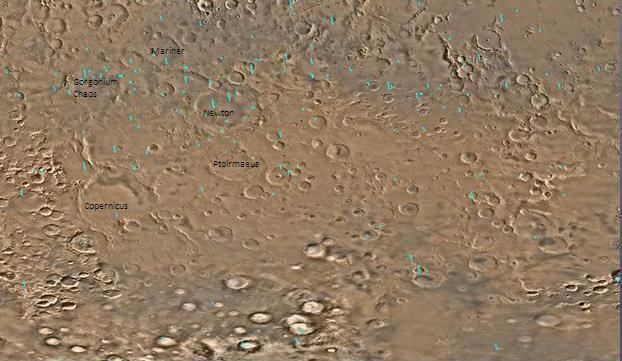Diameter 165.18 km | ||
 | ||
Eponym Claudius Ptolemaeus, a Greco-Egyptian astronomer (c | ||
Ptolemaeus Crater is a crater on Mars found in the Phaethontis quadrangle at 46.21° south latitude and 157.6° west longitude. It is 165.18 km in diameter and was named after Claudius Ptolemaeus (Ptolemy), the Greco-Egyptian astronomer (c. AD 90-160). The Soviet probe Mars 3 is thought to have successfully landed in Ptolemaeus Crater in 1971, but contact was lost seconds after landing. Mantle material that is believed to have fallen from the sky is visible in the crater.
Ice-rich mantle
Much of the surface of Mars is covered by a thick smooth mantle that is thought to be a mixture of ice and dust. This ice-rich mantle, a few yards thick, smoothes the land, but in places it has a bumpy texture, resembling the surface of a basketball. Under certain conditions the ice could melt and flow down the slopes to create gullies. Because there are few craters on this mantle, the mantle is relatively young. An excellent view of this mantle is shown below in the picture of the Ptolemaeus Crater Rim, as seen by HiRISE.
Changes in Mars's orbit and tilt cause significant changes in the distribution of water ice from polar regions down to latitudes equivalent to Texas. During certain climate periods water vapor leaves polar ice and enters the atmosphere. The water comes back to ground at lower latitudes as deposits of frost or snow mixed generously with dust. The atmosphere of Mars contains a great deal of fine dust particles. Water vapor will condense on the particles, then fall down to the ground due to the additional weight of the water coating. When ice at the top of the mantling layer goes back into the atmosphere, it leaves behind dust, which insulating the remaining ice.
